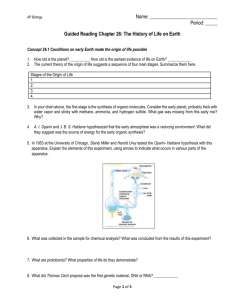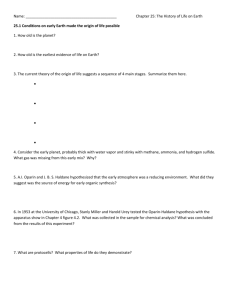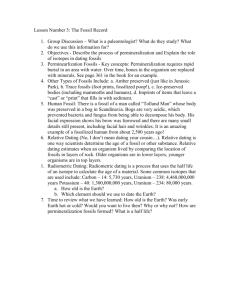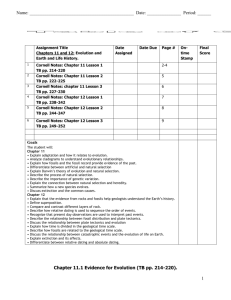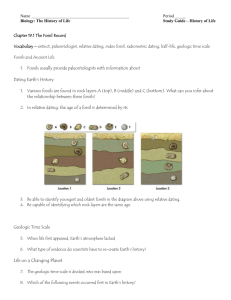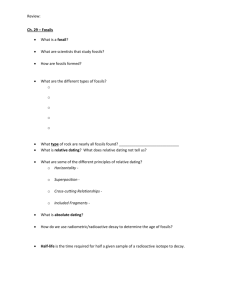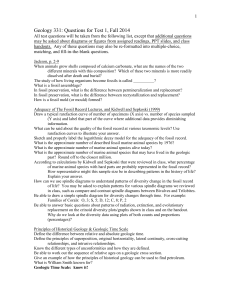Chapter 25: The History of Life on Earth Reading Guide Overview In
advertisement
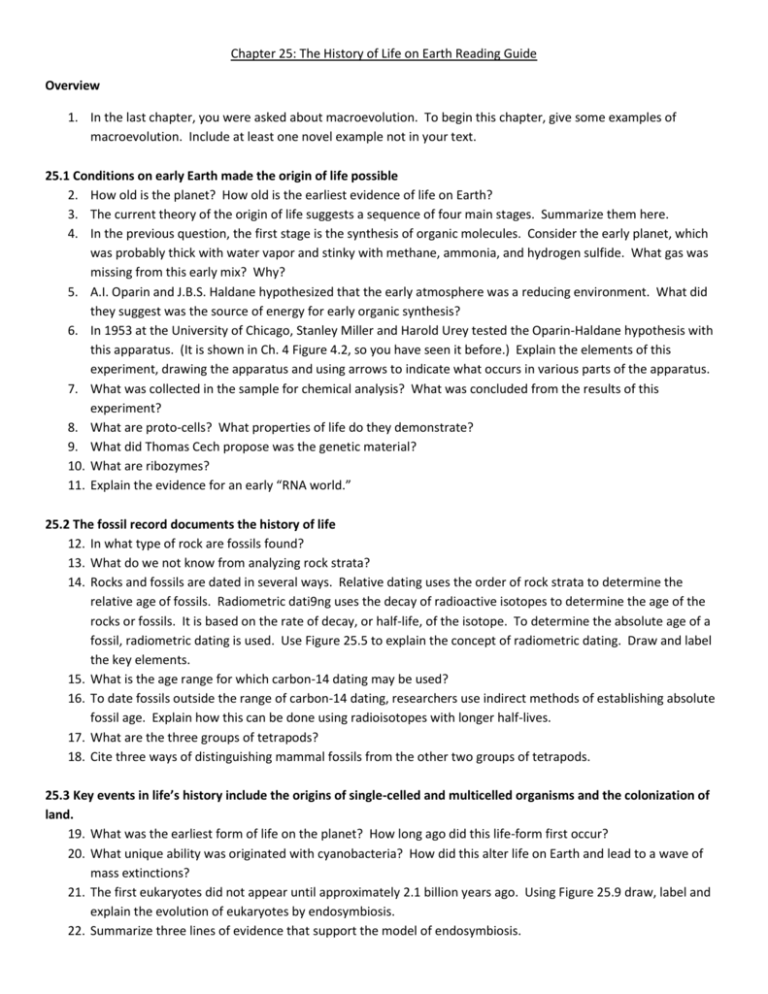
Chapter 25: The History of Life on Earth Reading Guide Overview 1. In the last chapter, you were asked about macroevolution. To begin this chapter, give some examples of macroevolution. Include at least one novel example not in your text. 25.1 Conditions on early Earth made the origin of life possible 2. How old is the planet? How old is the earliest evidence of life on Earth? 3. The current theory of the origin of life suggests a sequence of four main stages. Summarize them here. 4. In the previous question, the first stage is the synthesis of organic molecules. Consider the early planet, which was probably thick with water vapor and stinky with methane, ammonia, and hydrogen sulfide. What gas was missing from this early mix? Why? 5. A.I. Oparin and J.B.S. Haldane hypothesized that the early atmosphere was a reducing environment. What did they suggest was the source of energy for early organic synthesis? 6. In 1953 at the University of Chicago, Stanley Miller and Harold Urey tested the Oparin-Haldane hypothesis with this apparatus. (It is shown in Ch. 4 Figure 4.2, so you have seen it before.) Explain the elements of this experiment, drawing the apparatus and using arrows to indicate what occurs in various parts of the apparatus. 7. What was collected in the sample for chemical analysis? What was concluded from the results of this experiment? 8. What are proto-cells? What properties of life do they demonstrate? 9. What did Thomas Cech propose was the genetic material? 10. What are ribozymes? 11. Explain the evidence for an early “RNA world.” 25.2 The fossil record documents the history of life 12. In what type of rock are fossils found? 13. What do we not know from analyzing rock strata? 14. Rocks and fossils are dated in several ways. Relative dating uses the order of rock strata to determine the relative age of fossils. Radiometric dati9ng uses the decay of radioactive isotopes to determine the age of the rocks or fossils. It is based on the rate of decay, or half-life, of the isotope. To determine the absolute age of a fossil, radiometric dating is used. Use Figure 25.5 to explain the concept of radiometric dating. Draw and label the key elements. 15. What is the age range for which carbon-14 dating may be used? 16. To date fossils outside the range of carbon-14 dating, researchers use indirect methods of establishing absolute fossil age. Explain how this can be done using radioisotopes with longer half-lives. 17. What are the three groups of tetrapods? 18. Cite three ways of distinguishing mammal fossils from the other two groups of tetrapods. 25.3 Key events in life’s history include the origins of single-celled and multicelled organisms and the colonization of land. 19. What was the earliest form of life on the planet? How long ago did this life-form first occur? 20. What unique ability was originated with cyanobacteria? How did this alter life on Earth and lead to a wave of mass extinctions? 21. The first eukaryotes did not appear until approximately 2.1 billion years ago. Using Figure 25.9 draw, label and explain the evolution of eukaryotes by endosymbiosis. 22. Summarize three lines of evidence that support the model of endosymbiosis. 23. Use the clock model to note the following events in the life of the planet: origin of Earth, appearance of prokaryotes, evolution of atmospheric oxygen, occurrence of eukaryotic cells, multicellularity, and life moves onto land. For each event, also label the number of years ago it occurred. 25.4 The rise and fall of groups of organisms reflect differences in speciation and extinction rates 24. If you have not studies geology, you will find this concept introduces a fascinating look at the changes in our planet as explained by continental drift. Define continental drift. How can continents move? 25. Draw the time in Figure 25.14, label Pangaea, Gondwana, and Laurasia. Where was India 65 million years ago? 26. See if you can answer each of these short questions: a. What is the San Andreas Fault? b. What caused the uplift of the Himalayas? c. How can a fossil freshwater reptile be found in both Brazil and West Africa, areas separate today by a wide expanse of ocean? d. Why are no eutherian (placental) mammals indigenous to Australia? 27. A mass extinction is the loss of large numbers of species in a short period, caused by global environmental changes. What caused the Permian mass extinction 250 million years ago (mya)? Summarize the species that were lost. 28. A second important mass extinction is the Cretaceous mass extinction that happened about 65 million years ago. Everyone’s favorite group, the dinosaurs, was lost, along with more than half of all marine species. What caused it? 29. What are adaptive radiations? 30. Why did large-scale adaptive radiation occur after each mass extinction?
